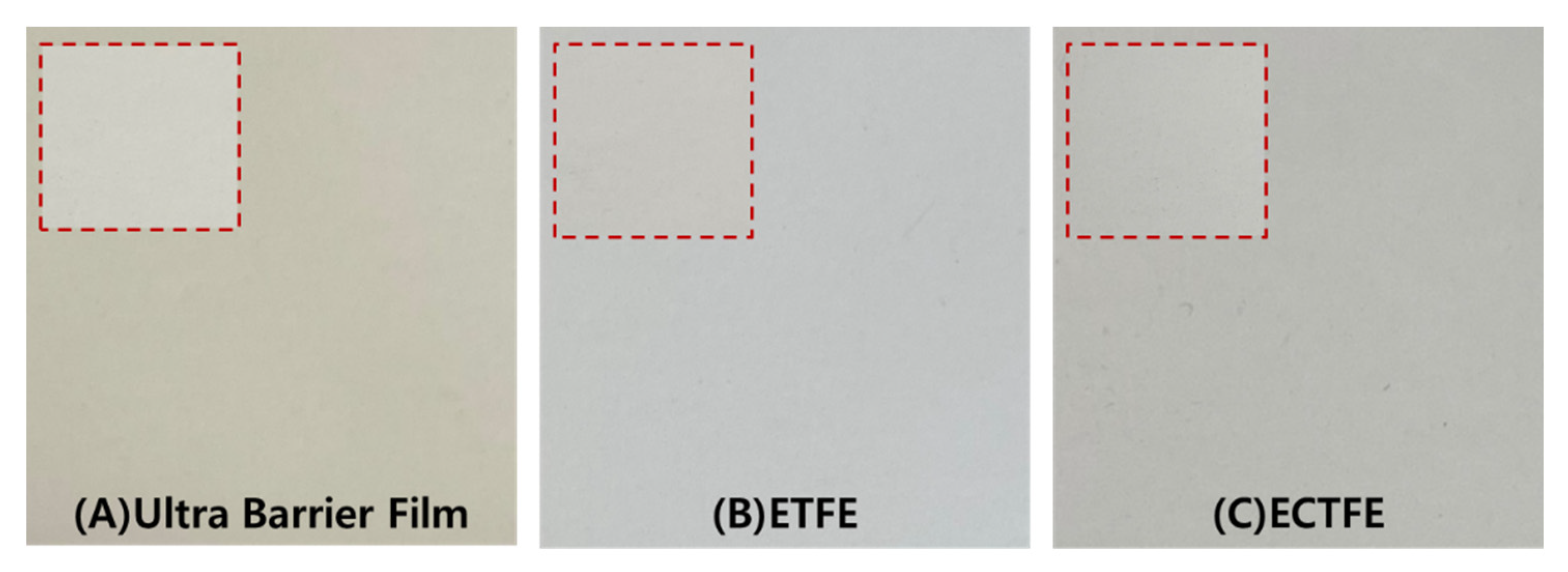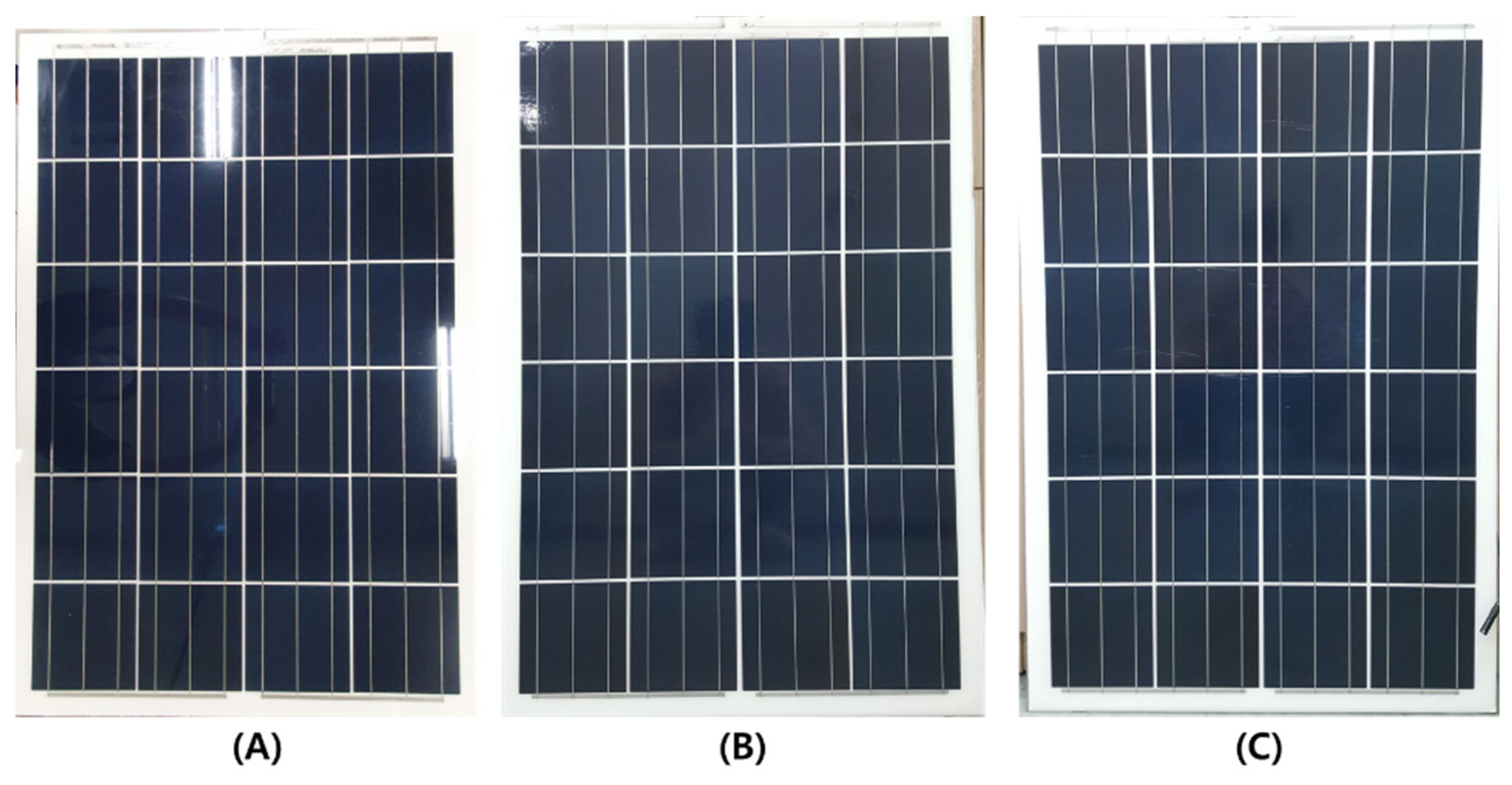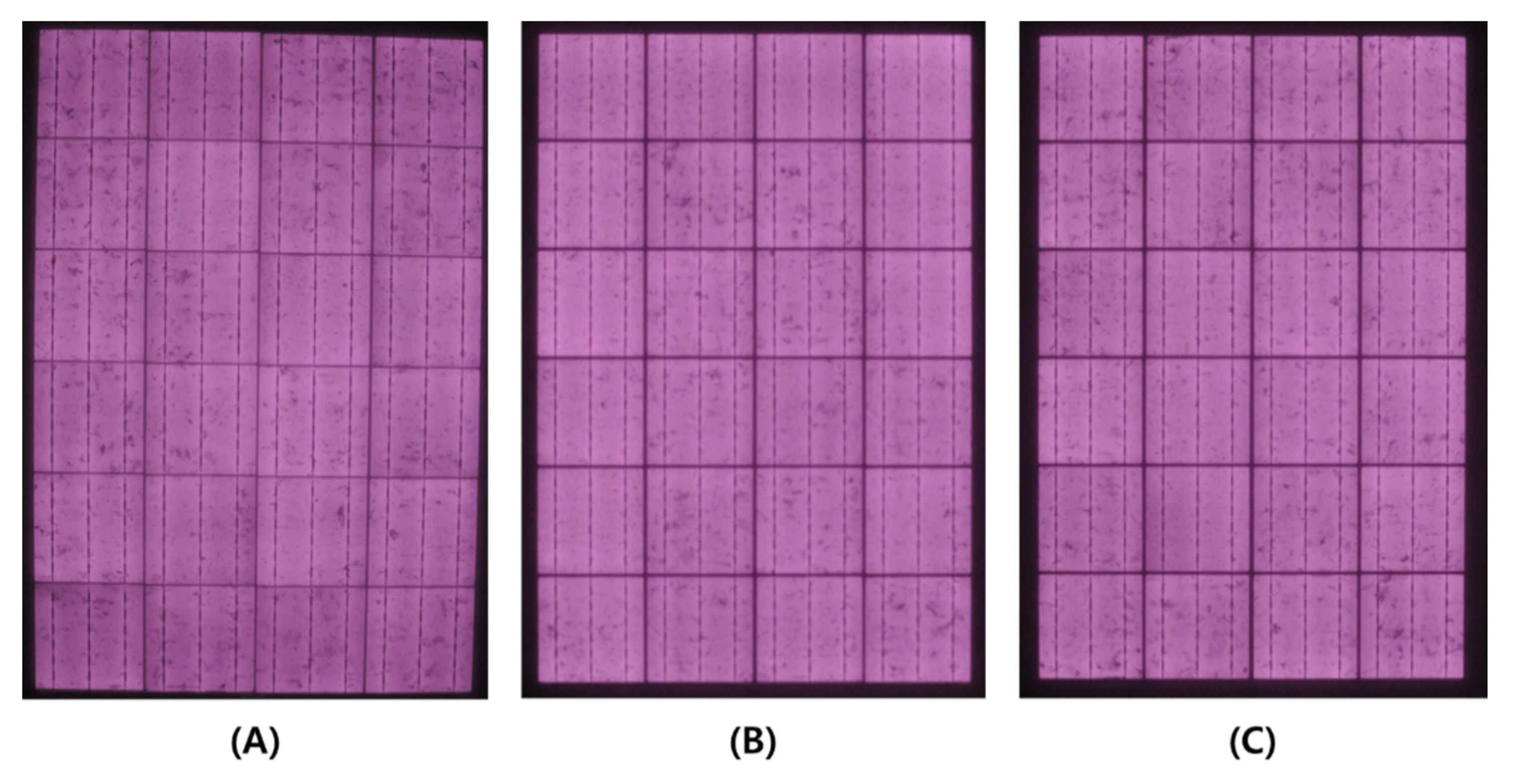A Study of the Electrical Output and Reliability Characteristics of the Crystalline Photovoltaic Module According to the Front Materials
Abstract
:1. Introduction
2. Characteristic Analysis of Front materials
2.1. Analysis of Transmittance Characteristic of Front Materials
2.2. UV Characteristic Analysis of Front-Surface Materials of PV Module
3. Experiment on the Electrical Output and Reliability Characteristics of Front Materials of PV Module
3.1. Analysis on the Electrical Output of PV Module
3.2. Reliability Analysis of ETFE, ECTFE and Ultra-Barrier Film PV Module
4. Conclusions
- (1)
- In order to apply the film as the front-surface material of the PV module, the material characteristics were analyzed, and one-cell and 24-cell modules were manufactured and tested for their electrical output and reliability.
- (2)
- The difference in electrical output of the PV modules to which the front-surface film was applied was equal to 1W or less.
- (3)
- As a result of damp heat and thermal cycle reliability tests, the reduction in the electrical output modules with front-surface films was within 5%, which is the certification standard.
- (4)
- If the mechanical strength is increased by using a reinforcing material on the back side, it is believed that these films can be used as the front-surface material of the PV module.
Author Contributions
Funding
Acknowledgments
Conflicts of Interest
References
- Ha, S.W.; Park, S.H.; Eom, J.Y.; Oh, M.S.; Cho, G.Y.; Kim, E.J. Parameter calibration for a TRNSYS BIPV model using in situ test data. Energies 2020, 13, 4935. [Google Scholar] [CrossRef]
- Shukla, A.K.; Sudhakar, K.; Baredar, P. Recent advancement in BIPV product technologies: A review. Energy Build. 2017, 140, 188–195. [Google Scholar] [CrossRef]
- Gagnon, P.; Margolis, R.; Melius, J.; Phillips, C.; Elmore, R. Rooftop Solar Photovoltaic Technical Potential in the United States. A Detailed Assessment (No. NREL/TP-6A20-65298); National Renewable Energy Lab. (NREL): Golden, CO, USA, 2016. [Google Scholar]
- Al-Janahi, S.A.; Ellabban, O.; Al-Ghamdi, S.G. A Novel BIPV reconfiguration algorithm for maximum power generation under partial shading. Energies 2020, 13, 4470. [Google Scholar] [CrossRef]
- Mittag, M.; Ebert, M.; Wilson, H.R.; Fellmeth, T. Mosaic Module concept for cost-efficient and aesthetic BIPV modules. In Proceedings of the 35th European PV Solar Energy Conference and Exhibition, Brussels, Belgium, 24–28 September 2018. [Google Scholar]
- Saretta, E.; Bonomo, P.; Frontini, F. BIPV meets customizable glass: A dialogue between energy efficiency and aesthetics. In Proceedings of the 35th European Photovoltaic Solar Energy Conference and Exhibition, EUPVSEC, Brussels, Belgium, 24–28 September 2018; pp. 1472–1477. [Google Scholar]
- Tzikas, C.; Bognár, Á.; Loonen, R.C.; Hensen, J. Outdoor characterization of colored and textured prototype PV facade elements. In Proceedings of the 35th European Photovoltaic Solar Energy Conference and Exhibition, Brussels, Belgium, 24–28 September 2018; pp. 1468–1471. [Google Scholar]
- Halbe, A.; Novak, J.; Sharpe, K.; Housser, G.; Haldars, P. Evaluation of mounting mechanisms for the installation of lightweight PV systems on commercial rooftops. In Proceedings of the 2014 IEEE 40th Photovoltaic Specialist Conference (PVSC), Denver, CO, USA, 8–13 June 2014; pp. 3539–3542. [Google Scholar]
- Honeker, C.; Fuller, E.; Watts, A.; Booth, D.; Flaherty, B.; Mao, E. Reducing installed costs of residential solar by the use of adhesive mounted lightweight solar modules. In Proceedings of the 2016 IEEE 43rd Photovoltaic Specialists Conference (PVSC), Portland, OR, USA, 5–10 June 2016; pp. 3135–3140. [Google Scholar]
- Metacarpa, D.; Fobare, D.; Garney, A.; Yan, F.; Dwyer, D.; Holton, E.; Haldar, P. Reduced Balance of System Costs using Lightweight photovoltaics integrated with roofing material membranes. In Proceedings of the 2015 IEEE 42nd Photovoltaic Specialist Conference (PVSC), New Orleans, LA, USA, 14–19 June 2015; pp. 1–4. [Google Scholar]
- Agathokleous, R.; Kalogirou, S.A. Thermal testing of new photovoltaic (PV) modules for building integration, encapsulated with glass fibre reinforced composite materials and comparison with conventional Photovoltaic. In Proceedings of the First International Conference on Building Integrated Renewable Energy Systems, Dublin, Ireland, 6–9 March 2017. [Google Scholar]
- Martins, A.C.; Chapuis, V.; Virtuani, A.; Perret-Aebi, L.E.; Ballif, C. Hail resistance of composite-based glass-free lightweight modules for building integrated photovoltaics applications. In Proceedings of the 33rd European Photovoltaic Solar Energy Conference and Exhibition, No. CONF, Amsterdam, The Netherlands, 25–27 September 2017; pp. 2604–2608. [Google Scholar]
- Martins, A.C.; Chapuis, V.; Virtuani, A.; Ballif, C. Robust glass-free lightweight photovoltaic modules with improved resistance to mechanical loads and impact. IEEE J. Photovolt. 2018, 9, 245–251. [Google Scholar] [CrossRef]
- Martins, A.C.; Chapuis, V.; Virtuani, A.; Li, H.Y.; Perret-Aebi, L.E.; Ballif, C. Thermo-mechanical stability of lightweight glass-free photovoltaic modules based on a composite substrate. Sol. Energy Mater. Sol. Cells 2018, 187, 82–90. [Google Scholar] [CrossRef]
- Brounne, M.; Heuseveldt, J.W.; Rosca, V.; Okel, L.A.G. Novel light-weight PV module design based on use of polycarbonate. In Proceedings of the 35th European Photovoltaic Solar Energy Conference and Exhibition, EUPVSEC, Brussels, Belgium, 24–28 September 2018; pp. 1–16. [Google Scholar]
- Raut, H.K.; Dinachali, S.S.; He, A.Y.; Ganesh, V.A.; Saifullah, M.S.; Law, J.; Ramakrishna, S. Robust and durable polyhedral oligomeric silsesquioxane-based anti-reflective nanostructures with broadband quasi-omnidirectional properties. Energy Environ. Sci. 2013, 6, 1929–1937. [Google Scholar] [CrossRef]
- Webstore (International Electrotechnical Commission). Available online: https://webstore.iec.ch/search form&q=IEC%2061215 (accessed on 10 December 2020).








| Product Thickness [mm] | Transmittance Average [%] | Maximum Transmittance | ||
|---|---|---|---|---|
| ARC (anti reflective coating) Glass | 0.875 | 3.2 | 95.07 [17] | 95.2 [17] |
| Ultra barrier film | 0.027 | 0.2 | 93.5 | 94.6 |
| Ethylene tetra fluoro-ethylene (ETFE) | 0.009 | 0.2 | 93.3 | 94.8 |
| Ethylene chlorotrifluoroethylene (ECTFE) | 0.006 | 0.05 | 93.7 | 94.2 |
| FF [%] | |||||
|---|---|---|---|---|---|
| Ultra-barrier film | 0.62 | 8.4 | 3.95 | 75.1 | 0.01 |
| ETFE | 0.62 | 8.5 | 4.01 | 74.9 | 0.01 |
| ECTFE | 0.62 | 8.5 | 4.00 | 74.0 | 0.01 |
| FF [%] | ||||
|---|---|---|---|---|
| Ultra-barrier film | 15.3 | 8.89 | 100.8 | 74.4 |
| ETFE | 15.3 | 8.94 | 101.5 | 74.2 |
| ECTFE | 15.3 | 8.97 | 101.8 | 74.2 |
Publisher’s Note: MDPI stays neutral with regard to jurisdictional claims in published maps and institutional affiliations. |
© 2020 by the authors. Licensee MDPI, Basel, Switzerland. This article is an open access article distributed under the terms and conditions of the Creative Commons Attribution (CC BY) license (http://creativecommons.org/licenses/by/4.0/).
Share and Cite
Lim, J.R.; Shin, W.G.; Lee, C.G.; Lee, Y.G.; Ju, Y.C.; Ko, S.W.; Kim, J.D.; Kang, G.H.; Hwang, H. A Study of the Electrical Output and Reliability Characteristics of the Crystalline Photovoltaic Module According to the Front Materials. Energies 2021, 14, 163. https://doi.org/10.3390/en14010163
Lim JR, Shin WG, Lee CG, Lee YG, Ju YC, Ko SW, Kim JD, Kang GH, Hwang H. A Study of the Electrical Output and Reliability Characteristics of the Crystalline Photovoltaic Module According to the Front Materials. Energies. 2021; 14(1):163. https://doi.org/10.3390/en14010163
Chicago/Turabian StyleLim, Jong Rok, Woo Gyun Shin, Chung Geun Lee, Yong Gyu Lee, Young Chul Ju, Suk Whan Ko, Jung Dong Kim, Gi Hwan Kang, and Hyemi Hwang. 2021. "A Study of the Electrical Output and Reliability Characteristics of the Crystalline Photovoltaic Module According to the Front Materials" Energies 14, no. 1: 163. https://doi.org/10.3390/en14010163
APA StyleLim, J. R., Shin, W. G., Lee, C. G., Lee, Y. G., Ju, Y. C., Ko, S. W., Kim, J. D., Kang, G. H., & Hwang, H. (2021). A Study of the Electrical Output and Reliability Characteristics of the Crystalline Photovoltaic Module According to the Front Materials. Energies, 14(1), 163. https://doi.org/10.3390/en14010163




